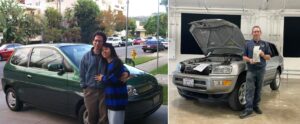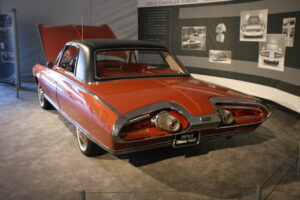Most of the country thinks of driving a battery electric vehicle as a new and risky experiment. While this may have been true 25 years ago, it is not the case today. My wife and I drove off the showroom floor in a brand-new Honda EV Plus on January 15, 1999, over 25 years ago. Since then, we have owned several other Battery EVs (BEVs), and as of this month, we have driven over 360K miles on battery power.
Modern EVs have all the features one might expect in any vehicle. They are reliable, easy to drive, offer good, if not exceptional, performance, and have the same modern comforts. The primary difference between modern EVs and others is that they are driven with an electric motor instead of gasoline.
The origin of the modern EV era traces back to late 1986 when some engineers from the Australian division of General Motors (Holden) requested the then Chairman of GM, Roger Smith, in Detroit, to compete in the world’s first solar-powered car race, the “World Solar Challenge,” at the end of 1987. Smith got behind the concept, and in just ten months, GM (working with AeroVironment) built the Sunraycer that not only competed but won the event. This impact inspired GM (again working with AeroVironment) to develop and announce a concept car at the Los Angeles Auto Show in January 1990, the GM “Impact.”
This not only captured my imagination, it was the Impact that really inspired the California Air Resources Board (CARB) to create the “California Zero-emission Vehicle Mandate of 1990” (aka “ZEV mandate”, Memorandum of Agreement/MOA) as part of the LEV (Low Emissions Vehicle) program that was exclusively focused on emissions and not other factors like oil sources or market forces. This mandate enabled the first modern generation of EVs to exist. The GM Impact concept became the GM EV1, and from 1996-1999 GM leased 1,117 of them as the first modern production electric car, followed by Toyota (Rav4EV), Ford (Ranger EV), Honda (EV Plus), and Nissan (Altra EV) Chrysler (TEVan), Dodge (Caravan EPIC) as well as Chevrolet (S10 Electric). A total combined production of approximately 5500 “compliance vehicles” were built from 1996-2003. Virtually all of these were leased vehicles to fleets or leased to the public; however, in 2002, Toyota decided to offer 339 Rav4Evs to the public for lease and purchase. In the mid-2000s, about 60 GM S10 Electrics and 400 Ford Ranger EVs were sold after their leases ran out.

The history is complicated, but in summary, after lawsuits and pressure from GM and others, the ZEV mandate was watered down over the years with a less and less aggressive target. By 2003, CARB withdrew the mandate. By 2004, all the participating car companies ended their EV programs. The manufacturers worked to recover their leased cars and destroyed nearly all of them, although some were sent to museums or universities after being disabled. This period was accurately documented in the movie “Who Killed the Electric Car.”
It was their active destruction of these cars and the development programs that created them that became the catalyst that inspired Martin Eberhard and Marc Tarpenning (before Elon Musk was part of the company) to create Tesla Motors and start designing their first car, the Tesla Roadster. In 2008, the Tesla Roadster was the first EV available to the public for sale to offer a stunning design (based on a very customized Lotus Elise), exceptional performance (0-60 in 4.4 seconds), and an unprecedented 244-mile range. The Roadster re-inspired CARB and the industry to work towards a battery-powered future. The first major manufacturers to the market were Nissan with the Leaf and Chevrolet with the Volt, a range-extended EV (PHEV). These cars, in their final forms by 2010, really began the current wave of PEVs (Plug-in EVs) as 2011 model year vehicles.
With Tesla moving to a more mass-production electric vehicle, the Model S, in 2012, most major car companies began showing concept EVs, and then each started deliveries of a model or two within a few more years, and the rest, as they say, is history.
Perpetual Misinformation Campaign
Over the past 25+ years, there has been a very consistent series of doom and gloom stories about how EVs just don’t work, no one wants them, and how they are not selling. Part of this problem is the lack of knowledge by the car salesperson/dealership not knowing how to explain the advantages of an EV, not to mention that most dealerships profit more money on the service of a vehicle, not the sale.
The reality is sales every year are breaking records not only in the USA but also around the world. Last year, there were just under 1.2 million new EVs sold in the USA, a new record. Looking at the data, the YoY (Year over Year) sales of BEV sales rose throughout all of 2023, and while sales in Q3 and Q4 2023 were slower in the 2nd half of the year, data shows YoY increased significantly over the same period in 2022. Follow the data, not the naysayers.
One repeating story every year is how EVs just don’t work in the cold. While it is certainly true that batteries have a reduced range during extreme cold, they absolutely work consistently and reliably. Just look at the success of EVs in Norway, where 23% of cars on the road are battery-powered. EVs do work in extreme weather, often better than gas cars in sub-zero temperatures.
Tesla sales continue to rise. However, the media hypes that Tesla’s market share is falling. Both are accurate because of new competition in the market. As of January 2024, in the United States alone, there are now 27 manufacturers offering 48 different BEV models in 269 different configurations, including sport and economy versions. This includes every segment in the market, from small economy cars to large luxury sedans and SUV’s and pickup trucks, with many new models being announced this year (and in future years).
The global market for BEVs is growing rapidly. It is growing in the USA, too. Unfortunately, the US market is not leading the way; however, this transition to battery-powered transportation will happen around the world regardless of what we do in the USA. China and Germany are leading the way in terms of development. In Germany last year, BEV sales were up 38% year over year and now have an 18% market share. When you add in PHEVs, PEVs are now 23.9% of all new car sales. China saw a YoY increase in PEV (Plug-in) sales of 61.9%, with BEV sales at 1.6M and 1.4M in PHEVs. EVs outsold diesel vehicles in Europe last year too (the largest market for diesel vehicles).
Most batteries will typically last the life of the car. It is accurate to say that the range will diminish over time. How fast depends on many factors, but battery management systems in modern EVs are very robust and many EVs see about 10% degradation over 100K miles. While batteries only have a warranty for 100-150K, the majority of EV batteries are expected to provide service life for at least 150-200K miles and some Tesla batteries have been shown to last 300-500K miles.
The reality is today, electrified vehicles (BEVs, PHEVs, and hybrids) are just blending into the fabric of our roads. Granted, this growth is faster in some parts of the country than others, but electrification of our transportation system will continue both in the USA and significantly around the world.
There are also massive benefits for the environment to switch to EVs.
The next “big thing” is going to come from batteries. There are now more than 60 new electric manufacturers working on electric planes. Battery power will be a large factor in the future of air travel, the first of which is in the skies today. Private boats and delivery vehicles are also switching to battery power, and that is not counting e-bikes, electric motorcycles, scooters, and other innovative transportation devices.
The reality is that EV sales are going to continue to increase both around the world and in America, and are practical and reliable for many people to have at least one in their household.
About the Author’s Automotive Journey
I am a lifelong “car guy,” but there is no question that an EV is simply a superior experience for daily commuting (for the majority of drivers). Vehicles that exclusively use an electric motor to make the car move are smoother, quieter, far more reliable, more efficient- and affordable to drive. EVs require less service and are typically much more responsive than a vehicle powered by an internal combustion engine. In our daily life for the past 25 years, the issue of “range anxiety” and limited public charging has been a non-issue for us. Initially, my wife was concerned about having to “plug it in,” but after she did it once and realized it was easy and convenient and the car had plenty of range for where she drove, she never looked back. My wife has not pumped gas in over 21 years (and not because she goes to full service).
The EV also offers an ability that no other technology can for the foreseeable future: refueling at home. Essentially, every home in the country has electricity. Many people and businesses (but granted, not everyone) can also add solar panels to their rooftops and generate electricity with electrons made in the USA.
Several factors attracted me to consider getting an EV over 25 years ago.
I have always been a “futurist/technologist” and have always focused on how technology can make our lives better. I really don’t get interested in something just because it is new; it must have a purpose or solve a problem. Growing up, I was an avid reader of Popular Science and Popular Mechanics magazines. My father always had new gadgets, and this inspired me to look for new and unique things.
I am also a life-long performance and classic car enthusiast. I have personally restored both original and modified muscle cars. I have driven cars on road race tracks, drag strips, and autocross courses. I have shown cars that I built at car shows and had one of my custom cars featured in multiple magazines. I have attended the Pebble Beach Concours D’Elegance for around 30 years. Growing up during the 1960s muscle car era, I was enthralled by cars long before I could drive them. I rebuilt my first engine when I was 14 years old. I read every car magazine I could get my hands on. Even as young as eight years old, I was fascinated and inspired by “alternative and unusual vehicles,” including the 1963 Chrysler Turbine Car and the Tucker 48.

I became a political junky during the Watergate era. Starting in the late 1970s, I became more aware of not only the pollution aspects of burning gasoline but also the Iranian hostage crisis, which informed me about the interrelated and political aspects of US policies regarding foreign oil. The ongoing unrest in the Middle East is all interrelated to the U.S.’s involvement in foreign governments going back to the 1950s as the world’s thirst for oil ramped up. The 1993 bombing of the World Trade Tower further inspired me to stop funding the terrorists who were trying to attack America with our oil money, and I saw EVs as a way to do that.
When I was young, I knew my asthma was exacerbated when the air quality was very poor. We used to have severe smog alerts all the time in Los Angeles; however, air quality has steadily improved over the 40+ years, in large part because of clean vehicles that have been promoted in California.
I was intrigued with the Sunraycer, but it was the announcement of the GM Impact that really inspired me; however, the single most transformative moment of my automotive journey was in late 1996 when I got behind the wheel of a GM EV1 for a test drive. It was like a switch got flipped, and at that moment, I knew the future of transportation would be electric. We really wanted the spaceship-like vehicle, but getting an expensive lease-only 2-seat sports car was not what we were looking for when we were planning on starting a family.
The Honda EV Plus was a much more traditional vehicle. It looked a bit like a mini minivan with two doors, but it had a spacious back seat and a 100-mile range. After a long application process, Honda accepted our application to lease one, and then we only had to wait about five months to get the car that we thought was going to be our “3rd vehicle”.
We quickly realized that even an EV with only 100 miles of range is practical for daily use in LA and more enjoyable to drive for daily use in real-world traffic.
In 2002 (also after a 5-month wait), we purchased a Rav4EV, and we still drive it today. It has batteries built in 2002 and is still reliable, with about 75-80% of the original range. We drove two EVs for 95% of our daily use for 15 months before the Honda lease ended.
We did not know any other EV drivers when we decided to order one, but we found a community of other EV drivers with whom we instantly bonded. Unfortunately, a few years later, our community tried and failed to stop the destruction of these cars and that battle was well-documented in the movie Who Killed the Electric Car.
Our experience of over 25+ years has shown that BEVs are very reliable and require much less maintenance or service than a gasoline vehicle; they are simply more fun and enjoyable to drive – and yes they really are significantly better for the planet too. Today, my family shares three battery EVs, two of which can go at least 260 miles on a charge and our Rav4EV. We also have one Chevy Volt that only consumed 3 gallons of gas last year. We will never purchase a car for daily driving that uses anything other than an electric motor to drive down the road.

Larry Paul has more than 25 years of professional experience in high-frame rate 2D and 3D as well as domes and curve screen systems that are used in high-end specialty display systems for theme park, giant screen, planetarium, visualization, and simulation applications. He has passion for and expertise in solving specific customer challenges and improving the user experience with design. He has been named as co-inventor on six patents. He worked with acclaimed film director Ang Lee on Gemini Man and Billy Lynn’s Long Halftime Walk, his two high-frame-rate film projects that were created and projected in limited release at 4K, 120Hz per eye in 3D. He also worked closely with special effects wizard Doug Trumbull on his Magi format.
Larry and his wife have been enthusiasts of mid-century modern design and architecture for over 30 years. They thoughtfully restored their Herb G. Reisenberg custom ranch home and are now doing a sensitive restoration and enhancement of a mid-century modern home designed by Paul R. Williams.
A life-long transportation enthusiast, Larry was part of a crew that restored a WWII flying wing. He has rebuilt and shown numerous classic and muscle cars. He is an advocate for the future of transportation with electric and autonomous vehicles, and he and his wife have now driven over 360,000+ miles in electric vehicles over the course of more than 25 years.






